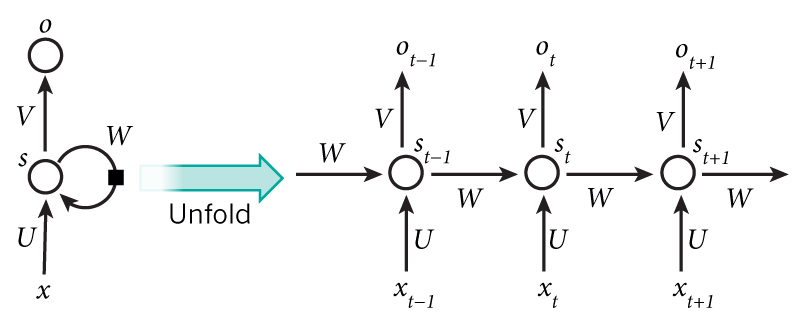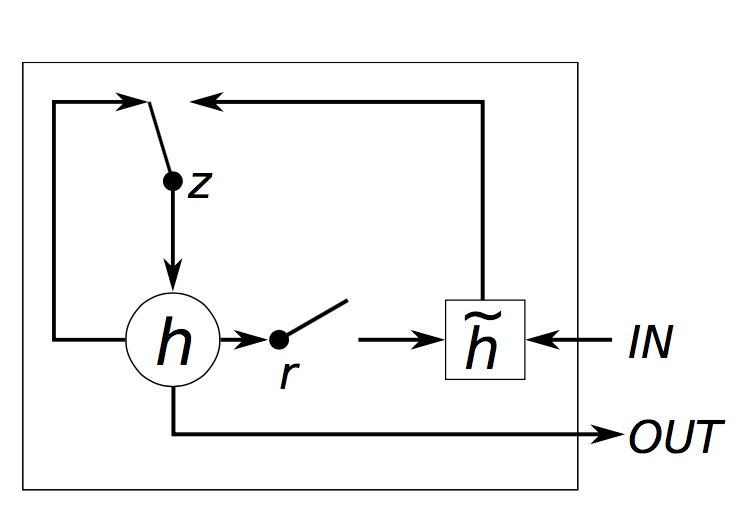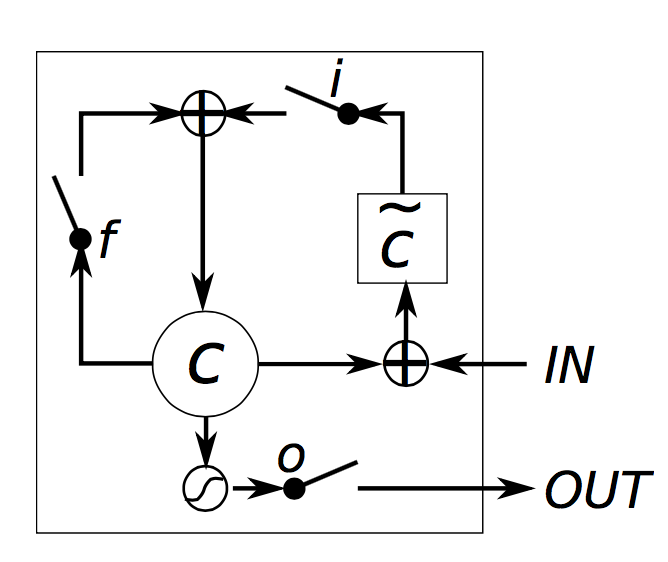這篇博客介紹RNN基礎(chǔ)。
具體關(guān)于RNN的細(xì)節(jié)介紹和實(shí)現(xiàn),推薦wildml的這個(gè)系列博客,一共四篇,帶你由淺入深學(xué)習(xí)RNN和Theano實(shí)現(xiàn)。補(bǔ)充:看到知乎上有人把這個(gè)系列翻譯出來了,可以看看。
另外,Karpathy(char-rnn的作者)的博客講了更多關(guān)于RNN和語言模型的知識。
這里我簡單總結(jié)下。
1. RNN
這里說的RNN特指循環(huán)神經(jīng)網(wǎng)絡(luò)(Recurrent Neural Network),先看下面這張圖:

簡單介紹下符號:

先看左邊沒有展開的圖,若輸入x直接到輸出o,那就是一個(gè)普通的神經(jīng)元;RNN就是在原來的基礎(chǔ)上,增加了一個(gè)中間狀態(tài)s,然后這個(gè)中間狀態(tài)會(huì)受到上一個(gè)時(shí)間點(diǎn)(序列中前一個(gè))中間狀態(tài)的影響。
按時(shí)間展開這個(gè)RNN單元,就可以獲得右邊的圖,U,V,W是唯一的。
用數(shù)學(xué)語言描述上面的圖:

下面給出theano實(shí)現(xiàn):
# 1.先定義單個(gè)時(shí)間序列下的計(jì)算規(guī)則
def forward_prop_step(x_t, s_t_prev, U, V, W):
s_t = T.tanh(U[:, x_t] + W.dot(s_t_prev))
o_t = T.nnet.softmax(V.dot(s_t))
return [o_t[0], s_t]
# 2.對輸入序列x,計(jì)算隱藏狀態(tài)序列s,和輸出序列o;thean中的scan相當(dāng)于for循環(huán)。
[o, s], updates = theano.scan(
forward_prop_step,
sequences=x,
outputs_info=[None, dict(initial=T.zeros(self.hidden_dim))],
non_sequences=[U, V, W],
truncate_gradient=self.bptt_truncate,
strict=True)
預(yù)測和損失函數(shù):
prediction = T.argmax(o, axis=1)
o_error = T.sum(T.nnet.categorical_crossentropy(o, y))
2. GRU(門限遞歸單元)
普通的RNN會(huì)有梯度消失的問題,即對于較長的輸入序列,會(huì)出現(xiàn)梯度為0的狀況。
于是產(chǎn)生了GRU(門限遞歸單元)和LSTM(長短項(xiàng)記憶)。
GRU:

解釋:

Theano實(shí)現(xiàn):
# 獲得embedding
x_e = E[:, x_t]
# GRU
z_t = T.nnet.hard_sigmoid(U[0].dot(x_e) + W[0].dot(s_t_prev) + b[0])
r_t = T.nnet.hard_sigmoid(U[1].dot(x_e) + W[1].dot(s_t_prev) + b[1])
h_t = T.tanh(U[2].dot(x_e) + W[2].dot(s_t_prev * r_t) + b[2])
s_t = (T.ones_like(z_t) - z_t) * h_t + z_t * s_t_prev
3. LSTM(長短項(xiàng)記憶)
繼續(xù)介紹LSTM:

解釋:

Tensorflow實(shí)現(xiàn):
參數(shù)定義:
# Parameters:
# Input gate: input, previous output, and bias.
ix = tf.Variable(tf.truncated_normal([vocabulary_size, num_nodes], -0.1, 0.1))
im = tf.Variable(tf.truncated_normal([num_nodes, num_nodes], -0.1, 0.1))
ib = tf.Variable(tf.zeros([1, num_nodes]))
# Forget gate: input, previous output, and bias.
fx = tf.Variable(tf.truncated_normal([vocabulary_size, num_nodes], -0.1, 0.1))
fm = tf.Variable(tf.truncated_normal([num_nodes, num_nodes], -0.1, 0.1))
fb = tf.Variable(tf.zeros([1, num_nodes]))
# Memory cell: input, state and bias.
cx = tf.Variable(tf.truncated_normal([vocabulary_size, num_nodes], -0.1, 0.1))
cm = tf.Variable(tf.truncated_normal([num_nodes, num_nodes], -0.1, 0.1))
cb = tf.Variable(tf.zeros([1, num_nodes]))
# Output gate: input, previous output, and bias.
ox = tf.Variable(tf.truncated_normal([vocabulary_size, num_nodes], -0.1, 0.1))
om = tf.Variable(tf.truncated_normal([num_nodes, num_nodes], -0.1, 0.1))
ob = tf.Variable(tf.zeros([1, num_nodes]))
# Variables saving state across unrollings.
saved_output = tf.Variable(tf.zeros([batch_size, num_nodes]), trainable=False)
saved_state = tf.Variable(tf.zeros([batch_size, num_nodes]), trainable=False)
# Classifier weights and biases.
w = tf.Variable(tf.truncated_normal([num_nodes, vocabulary_size], -0.1, 0.1))
b = tf.Variable(tf.zeros([vocabulary_size]))
計(jì)算規(guī)則:
def lstm_cell(i, o, state):
"""Create a LSTM cell. See e.g.: http://arxiv.org/pdf/1402.1128v1.pdf
Note that in this formulation, we omit the various connections between the
previous state and the gates."""
input_gate = tf.sigmoid(tf.matmul(i, ix) + tf.matmul(o, im) + ib)
forget_gate = tf.sigmoid(tf.matmul(i, fx) + tf.matmul(o, fm) + fb)
update = tf.matmul(i, cx) + tf.matmul(o, cm) + cb
state = forget_gate * state + input_gate * tf.tanh(update)
output_gate = tf.sigmoid(tf.matmul(i, ox) + tf.matmul(o, om) + ob)
return output_gate * tf.tanh(state), state
4. 一些細(xì)節(jié)
?
符號°代表矩陣的Element-wise product,也稱為Hadamard product。
?
在theano和tensorflow中,*直接表示Element-wise product。
?
而theano中的.dot和tensorflow中的tf.matmul,表示矩陣乘法。